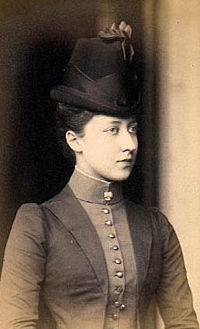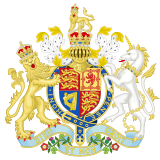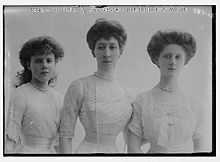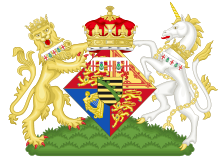- Louise, Princess Royal
-
Princess Louise Princess Royal, Duchess of Fife 
Spouse Alexander Duff, 1st Duke of Fife Issue Alastair, Marquess of Macduff
Princess Alexandra, Duchess of Fife
Princess Maud, Countess of SoutheskFull name Louise Victoria Alexandra Dagmar House House of Windsor
House of Saxe-Coburg and GothaFather Edward VII of the United Kingdom Mother Alexandra of Denmark Born 20 February 1867
Marlborough House, LondonDied 4 January 1931 (aged 63)
Portman Sq, LondonBurial St George's Chapel, Windsor British Royalty House of Saxe-Coburg and Gotha 
Edward VII Albert Victor, Duke of Clarence & Avondale George V Louise, Princess Royal Princess Victoria Maud, Queen of Norway Prince Alexander John Maternal grandchildren Alexandra, Duchess of Fife Maud of Fife The Princess Louise, Princess Royal and Duchess of Fife (Louise Victoria Alexandra Dagmar; 20 February 1867 – 4 January 1931) was the third child and the eldest daughter of King Edward VII and Alexandra of Denmark. She was the younger sister of George V and the fifth daughter of a British monarch to be styled Princess Royal.
Contents
Early life
The princess was born Princess Louise of Wales at Marlborough House, the London residence of her parents, then The Prince and Princess of Wales (later King Edward VII and Queen Alexandra). She spent much of her childhood at Sandringham House, her parents' country estate in Norfolk. Like her sisters, Princesses Maud and Victoria, she received a limited formal education. Her paternal grandmother was Queen Victoria, while her maternal grandfather was King Christian IX of Denmark
She was christened at Marlborough House on 10 May 1867 by Charles Longley, Archbishop of Canterbury.[1]
Marriage
On Saturday 27 July 1889, Princess Louise married the 6th Earl Fife (11 October 1849 – 12 January 1912), at the Private Chapel in Buckingham Palace.[2] He was eighteen years her senior, but her third cousin in descent from George III. Two days after the wedding, Queen Victoria created him Duke of Fife and Marquess of Macduff in the Peerage of the United Kingdom. The Letters Patent creating this dukedom contained the standard remainder to "male heirs of the body lawfully begotten." However, it eventually became apparent that the Duke and Duchess would not have a son. Therefore, on 24 April 1900, Queen Victoria signed Letters Patent creating a second Dukedom of Fife, along with the Earldom of Macduff in the Peerage of the United Kingdom with a special remainder: in default of a male heir, these peerages would pass to the daughters of the 1st Duke and then to their male descendants.
The Duke and Duchess of Fife had three children:
- Alastair Duff, Marquess of Macduff (stillborn 16 June 1890).
- HH Princess Alexandra of Fife (17 May 1891 – 26 February 1959) married her first cousin once removed, Prince Arthur of Connaught (13 January 1883 – 12 September 1938), and had issue.
- HH Princess Maud of Fife (3 April 1893 – 14 December 1945) married the 11th Earl of Southesk, and had issue.
Princess Royal
On 9 November 1905, Edward VII declared Princess Louise the Princess Royal, the highest honour bestowed on a female member of the Royal Family. Thereafter, she was styled HRH The Princess Royal. At the same time, the King declared that the two daughters of the Princess Royal would have the titular dignity of Princess of Great Britain and Ireland and the style of Highness, with precedence immediately after all members of the Royal Family holding the style of Royal Highness. From that point onward, the Princess Royal's daughters, styled Her Highness Princess Alexandra of Fife and Her Highness Princess Maud of Fife, no longer took their rank from their father, but rather from the will of the Sovereign.
In December 1911, while sailing to Egypt, the Princess Royal and her family were shipwrecked off the coast of Morocco. Although they escaped unharmed, the Duke of Fife fell ill with pleurisy, probably contracted as a result of the shipwreck. He died at Assuan, Egypt in January 1912, and Princess Alexandra succeeded to his dukedom, becoming Duchess of Fife in her own right. Princess Alexandra of Fife later married Prince Arthur of Connaught, a first cousin of Princess Louise. Alexandra, therefore, became known as HRH Princess Arthur of Connaught. She adopted the style of her husband, a Royal Highness, since he was the son of Prince Arthur, Duke of Connaught and Strathearn, the third son of Queen Victoria. Princess Louise is the maternal grandmother of the 3rd Duke of Fife.
Later life
Royal styles of
The Princess Royal
Reference style Her Royal Highness Spoken style Your Royal Highness Alternative style Ma'am Princess Louise of Wales received the Royal Order of Victoria and Albert in 1885 and the Imperial Order of the Crown of India in 1887. She became a Lady of the Venerable Order of St John of Jerusalem (LJStJ) in 1888 and a Dame Grand Cross (GCStJ) of that order in 1929. She became colonel-in-chief of the 7th Dragoon Guards (the Princess Royal's Own) in 1914. She later served as colonel-in-chief of the 4th and 7th Dragoon Guards when it was formed in 1921.
The Princess Royal died in January 1931, at her home in Portman Square, London and was buried in St. George's Chapel, Windsor Castle. Her remains were later removed to the Private Chapel, Mar Lodge Mausoleum, Braemar, Aberdeenshire.
Titles, styles, honours and arms
Titles and styles
- 20 February 1867 – 27 June 1889: Her Royal Highness Princess Louise of Wales
- 27 June 1889 – 29 June 1889: Her Royal Highness Princess Louise, Countess Fife
- 29 June 1889 – 22 January 1901: Her Royal Highness Princess Louise, Duchess of Fife
- 22 January 1901 – 9 November 1905: Her Royal Highness The Princess Louise, Duchess of Fife
- 9 November 1905 – 4 January 1931: Her Royal Highness The Princess Royal
Arms
Upon her marriage, Princess Louise was granted a coat of arms, being those of the kingdom with an inescutcheon for Saxony, all differenced with a label argent of five points, the outer pair and centre bearing crosses gules, and the inner pair bearing thistles proper.[3] The inescutcheon was dropped by royal warrant in 1917.
Ancestors
Notes
- ^ Her godparents were her paternal aunts – Alice, Princess Louis of Hesse, Helena, Princess Christian of Schleswig-Holstein and Princess Louise, Duchess of Argyll; her paternal uncle (by marriage), Crown Prince Frederick of Prussia; her first cousin once-removed – Grand Duchess Augusta of Mecklenburg-Strelitz; her maternal great-uncle – Elector Frederick William of Hesse-Kassel (or Hesse-Cassel); her maternal grandmother: Queen Louise of Denmark – for whom she was named; her children, Louise's uncle, George I of Greece; and aunt, Tsarina Maria Feodorovna of Russia; Duke Charles of Schleswig-Holstein-Sonderburg-Glücksburg; and Prince Edward of Saxe-Weimar-Eisenach.
- ^ Her bridesmaids were The Princesses Maud and Victoria of Wales, Victoria Mary of Teck, Marie Louise and Helena Victoria of Schleswig-Holstein and The Countesses Feodora, Helena and Victoria Gleichen
- ^ Heraldica – British Royal Cadency
Louise, Princess RoyalBorn: 20 February 1867 Died: 4 January 1931British royalty Vacant Title last held byPrincess VictoriaPrincess Royal
1905–1931Vacant Title next held byPrincess Mary, Countess of HarewoodPrincesses Royal Current title holder: HRH The Princess Anne, Princess Royal (since 1987)
Titles granted by reigning monarchs: Mary, Princess of Orange (1642–1660) • Anne, Princess of Orange (1727–1759) • Charlotte, Queen of Württemberg (1766–1828) • Victoria, German Empress (1841–1901) • Princess Louise, Duchess of Fife (1905–1931) • Princess Mary, Countess of Harewood (1932–1965) ·
Title granted by James II in exile: Princess Louisa Maria (1692–1712)
British princesses The generations indicate descent from George I, who formalised the use of the titles prince and princess for members of the British Royal Family. Where a princess may have been or is descended from George I more than once, her most senior descent, by which she bore or bears her title, is used.1st generation 2nd generation 3rd generation - Augusta, Duchess of Brunswick
- Princess Elizabeth
- Princess Louisa
- Caroline Matilda, Queen of Denmark and Norway
4th generation 5th generation 6th generation 7th generation - Louise, Princess Royal and Duchess of Fife
- Princess Victoria
- Maud, Queen of Norway
- Marie, Queen of Romania
- Victoria Melita, Grand Duchess of Hesse
- Alexandra, Princess of Hohenlohe-Langenburg
- Beatrice, Duchess of Galliera
- Margaret, Crown Princess of Sweden
- Patricia of Connaught
- Alice, Countess of Athlone
- Marie Louise, Princess Maximilian of Baden
- Alexandra, Grand Duchess of Mecklenburg-Schwerin
- Olga of Hanover
8th generation 9th generation - Queen Elizabeth II
- Margaret, Countess of Snowdon
- Alexandra, The Hon Lady Ogilvy
10th generation 11th generation Princesses (by birth) of Saxe-Coburg and Gotha, duchesses in Saxony 1st generation none2nd generation Victoria, Duchess of Nemours · Charlotte, Empress of Mexico*3rd generation Victoria, German Empress** · Alice, Grand Duchess of Hesse and by Rhine** · Helena, Princess Christian of Scheswig-Holstein** · Louise, Duchess of Argyll** · Beatrice, Princess Henry of Battenberg** · Clotilde, Archduchess Joseph Karl of Austria · Amalie, Duchess Maximilian Emanuel in Bavaria · Louise-Marie, Princess of Kohary* · Stéphanie, Crown Princess of Austria* · Henriette, Duchess of Vendôme* · Princess Joséphine-Marie* · Clémentine, Princess Napoléon* · Joséphine-Caroline, Princess Karl Anton of Hohenzollern*4th generation Louise, Duchess of Fife** · Princess Victoria** · Maud, Queen of Norway** · Marie, Queen of Romania** · Victoria Melita, Grand Duchess Cyril Vladimirovich of Russia** · Alexandra, Princess of Hohenlohe-Langenburg** · Beatrice, Duchess of Galliera** · Margaret, Crown Princess of Sweden** · Lady Patricia Ramsay** · Alice, Countess of Athlone** · Dorothea, Duchess of Schleswig-Holstein-Sonderburg-Augustenburg · Marie-José, Queen of Italy*5th generation Mary, Countess of Harewood** · Sibylla, Duchess of Västerbotten** · Caroline Mathilde, Countess of Castell-Rüdenhausen** · Princess Clementine, Mrs. Edward von Heller · Princess Maria Caroline · Theresia, Freifrau von Taxis di Bordogna e Valnigra · Princess Leopoldine · Princess Maria Immaculata · Josephine, Freifrau von Baratta-Dragono6th generation Princess Claudia, Mrs. Gion Schäfer · Beatrice Charlotte, Princess of Saxe-Meiningen7th generation Princess Stephanie · Princess Felicitas Franziska, Mrs. Sergei TrotzkiCategories:- 1867 births
- 1931 deaths
- British princesses
- Princesses Royal
- Women of the Victorian era
- People of the Edwardian era
- House of Saxe-Coburg and Gotha
- Companions of the Order of the Crown of India
- Dames Grand Cross of the Order of St John
- Ladies of the Royal Order of Victoria and Albert
- British duchesses by marriage
- People from Westminster
Wikimedia Foundation. 2010.


